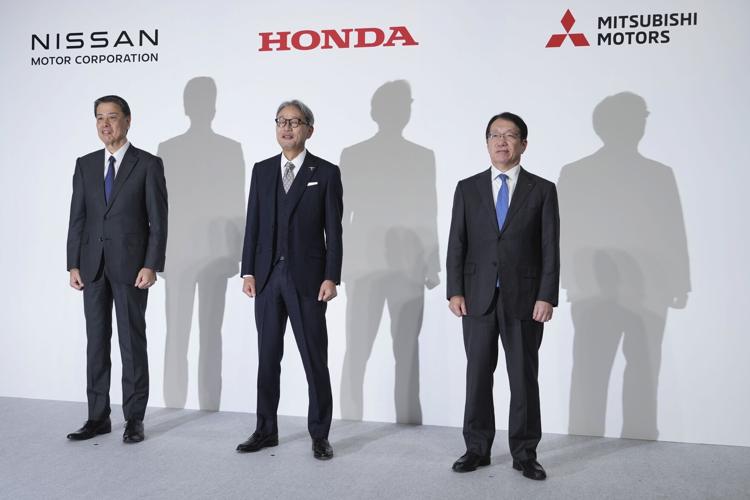BANGKOK — Japanese automakers Honda and Nissan will attempt to merge and create the world's third-largest automaker by sales as the industry undergoes dramatic changes in its transition away from fossil fuels.
The two companies said they had signed a memorandum of understanding on Monday and that smaller Nissan alliance member Mitsubishi Motors also had agreed to join the talks on integrating their businesses. Honda will initially lead the new management, retaining the principles and brands of each company.
Following is a quick look at what a combined Honda and Nissan would mean for the companies, and for the auto industry.

Nissan Chief Executive Makoto Uchida, left, and Honda Chief Executive Toshihiro Mibe, center, and Takao Kato CEO of Mitsubishi Motors, right, arrive to attend a joint news conference Monday, Dec. 23, 2024, in Tokyo, Japan. (AP Photo/Eugene Hoshiko)
An industry shakeup
The ascent of Chinese automakers is rattling the industry at a time when manufacturers are struggling to shift from fossil fuel-driven vehicles to electrics. Relatively inexpensive EVs from China's BYD, Great Wall and Nio are eating into the market shares of U.S. and Japanese car companies in China and elsewhere.
People are also reading…
Japanese automakers have lagged behind big rivals in EVs and are now trying to cut costs and make up for lost time.
Nissan, Honda and Mitsubishi announced in August that they will share components for electric vehicles like batteries and jointly research software for autonomous driving to adapt better to dramatic changes in the auto industry centered around electrification. A preliminary agreement between Honda, Japan's second-largest automaker, and Nissan, third largest, was announced in March.
A merger could result in a behemoth worth about $55 billion based on the market capitalization of all three automakers.
Joining forces would help the smaller Japanese automakers add scale to compete with Japan's market leader Toyota Motor Corp. and with Germany's Volkswagen AG. Toyota itself has technology partnerships with Japan's Mazda Motor Corp. and Subaru Corp.

Nissan Chief Executive Makoto Uchida, left, Honda Chief Executive Toshihiro Mibe, center, and Takao Kato, CEO of Mitsubishi Motors, right, pose for photographers during a joint news conference in Tokyo, Japan, Monday, Dec. 23, 2024. (AP Photo/Eugene Hoshiko)
What would Honda need from Nissan?
Nissan has truck-based body-on-frame large SUVs such as the Armada and Infiniti QX80 that Honda doesn't have, with large towing capacities and good off-road performance, said Sam Fiorani, vice president of AutoForecast Solutions.
Nissan also has years of experience building batteries and electric vehicles, and gas-electric hybird powertrains that could help Honda in developing its own EVs and next generation of hybrids, he said.
"Nissan does have some product segments where Honda doesn't currently play," that a merger or partnership could help, said Sam Abuelsamid, a Detroit-area automotive industry analsyt.
While Nissan's electric Leaf and Ariya haven't sold well in the U.S., they're solid vehicles, Fiorani said. "They haven't been resting on their laurels, and they have been developing this technology," he said. "They have new products coming that could provide a good platform for Honda for its next generation."
Why now?
Nissan said last month that it was slashing 9,000 jobs, or about 6% of its global work force, and reducing global production capacity by 20% after reporting a quarterly loss of 9.3 billion yen ($61 million).
Earlier this month it reshuffled its management and its chief executive, Makoto Uchida, took a 50% pay cut to take responsibility for the financial woes, saying Nissan needed to become more efficient and respond better to market tastes, rising costs and other global changes.
Fitch Ratings recently downgraded Nissan's credit outlook to "negative," citing worsening profitability, partly due to price cuts in the North American market. But it noted that it has a strong financial structure and solid cash reserves that amounted to 1.44 trillion yen ($9.4 billion).
Nissan's share price has fallen to the point where it is considered something of a bargain. A report in the Japanese financial magazine Diamond said talks with Honda gained urgency after the Taiwan maker of iPhones Hon Hai Precision Industry Co., better known as Foxconn, began exploring a possible acquisition of Nissan as part of its push into the EV sector.
The company has struggled for years following a scandal that began with the arrest of its former chairman Carlos Ghosn in late 2018 on charges of fraud and misuse of company assets, allegations that he denies. He eventually was released on bail and fled to Lebanon.
Honda reported its profits slipped nearly 20% in the first half of the April-March fiscal year from a year earlier, as sales suffered in China.
More headwinds
Toyota made 11.5 million vehicles in 2023, while Honda rolled out 4 million and Nissan produced 3.4 million. Mitsubishi Motors made just over 1 million. Even after a merger Toyota would remain the leading Japanese automaker.
All the global automakers are facing potential shocks if President-elect Donald Trump follows through on threats to raise or impose tariffs on imports of foreign products, even from allies like Japan and neighboring countries like Canada and Mexico. Nissan is among the major car companies that have adjusted their supply chains to include vehicles assembled in Mexico.
Meanwhile, analysts say there is an "affordability shift" taking place across the industry, led by people who feel they cannot afford to pay nearly $50,000 for a new vehicle. In American, a vital market for companies like Nissan, Honda and Toyota, that's forcing automakers to consider lower pricing, which will eat further into industry profits.
____
AP Auto Writer Tom Krisher contributed to this report from Detroit.
The safest cars in 2025
The safest cars in 2025

Airbags, advanced driver assistance features, and high-strength materials mean that the safest cars today are far better at protecting people from injuries than ever before. Although most new cars compare well to their predecessors, some stand above the rest. The safest cars for 2025 offer excellent occupant protection and also do a good job of preventing accidents from happening in the first place.
Based on testing data from the Insurance Institute for Highway Safety, or IIHS, and the National Highway Traffic Safety Administration, or NHTSA, these are some of the safest cars available today. Ranging from inexpensive compact cars and mainstream midsize sedans to stylish station wagons, posh luxury cars, and sporty coupes and convertibles, Edmunds shares a list that has something for just about everyone. For those who prefer a higher seating position and maybe some added practicality, Edmunds' list of safest SUVs is for you.

Safest Small Cars

2025 Mazda 3
The stylish Mazda 3 has a lot to offer compact-car shoppers, including great looks, a composed driving experience, and reasonable fuel economy from its base 2.0-liter engine. It's also one of the safest cars in its class, earning a perfect five stars in NHTSA crash testing and sterling crashworthiness and collision avoidance scores from the IIHS. Its standard features are forward collision warning, automatic emergency braking, and lane departure prevention.
- Base price: $25,135
- NHTSA rating: five stars
- IIHS rating: Top Safety Pick+
- Edmunds Rating: 7.6 (out of 10)
2025 Honda Civic
With mature styling, a premium interior, and an efficient hybrid powertrain option, the 2025 Honda Civic is a great option if safety is a concern since it aces almost all of the IIHS' crash tests and earns a five-star safety rating from the federal government. It also comes standard with adaptive cruise control, lane departure prevention, and forward collision warning with automatic emergency braking. The Civic falls short slightly in the IIHS' updated moderate overlap front test, which now accounts for rear passenger safety, but even so, it's one of the safest cars in its class.
- Base price: $25,345
- NHTSA rating: five stars
- IIHS rating: Top Safety Pick+
- Edmunds Rating: 8.2 (out of 10)
2025 Mini Cooper
Reflective of parent company BMW, today's Mini Cooper is well constructed and features premium safety features that belie its small size, including automatic emergency braking and forward collision warning. Although the Mini hasn't been tested by NHTSA, the IIHS gives the Cooper its highest score of Good in the original driver-side small overlap front, moderate overlap front, and side-impact tests.
That said, the IIHS doesn't place the Cooper on its Top Safety Pick or Top Safety Pick+ lists since it hasn't been evaluated on the updated battery of passenger-side small overlap front, moderate overlap front, or side-impact tests. Expect the new-for-2025 Mini Cooper to earn decent crash ratings in those scenarios, especially since it shares its strong platform with the outgoing model.
- Base price: $33,195
- NHTSA rating: not tested
- IIHS rating: not rated
- Edmunds Rating: 7.5 (out of 10)
2025 Toyota Prius
With its recent redesign, the Toyota Prius transformed from a frumpy little caterpillar to a stylish and efficient butterfly. It also became a very safe hybrid hatchback. Perfect scores in all of its government and IIHS crash tests, as well as a sophisticated system of collision avoidance technology, earn it top marks. It's also one of our favorite cars on the market, period, as evidenced by its status as a 2024 Edmunds Top Rated vehicle.
- Base price (2024): $29,045
- NHTSA rating: five stars
- IIHS rating: Top Safety Pick+
- Edmunds Rating: 8.0 (out of 10)
Safest Midsize Cars

2025 Honda Accord
The Honda Accord is among the safest midsize sedans on the market today thanks to excellent crashworthiness scores and a competent standard collision prevention system. It's a Top Safety Pick+, beating out rivals like the Hyundai Sonata, Kia K5, and Subaru Legacy, and the Accord also earns a perfect five-star rating from NHTSA. Honda's hybrid-intensive product planning is on full display here—all but the two lowest Accord trims have a hybrid powertrain—and it's also among the most spacious cars in its class.
- Base price: $29,390
- NHTSA rating: five stars
- IIHS rating: Top Safety Pick+
- Edmunds Rating: 8.0 (out of 10)
2025 Toyota Camry
Like its Honda Accord rival, the Toyota Camry is also an IIHS Top Safety Pick+ with a five-star NHTSA rating. It also has a very impressive suite of driver assistance and safety technology, including lane departure prevention with active centering, full-speed adaptive cruise control, and automatic emergency braking. The Camry edges out the Accord in IIHS testing thanks to a more effective collision avoidance system, but both cars are remarkably well matched otherwise.
- Base price: $29,495
- NHTSA rating: five stars
- IIHS rating: Top Safety Pick+
- Edmunds Rating: 8.1 (out of 10)
2025 Hyundai Ioniq 6
The fully electric Hyundai Ioniq 6 offers excellent safety and collision prevention, with excellent scores across the entire line of IIHS tests. The Ioniq 6 hasn't been tested for rollover resistance by NHTSA, but it earned a four-star front safety rating and a five-star side-impact rating in government tests. Like most EVs, the Hyundai Ioniq 6 comes standard with forward collision warning, automatic emergency braking, and lane departure prevention. It also offers up to 342 miles of all-electric driving in its longest-range trim level.
- Base price: $38,900
- NHTSA rating: not rated
- IIHS rating: Top Safety Pick+
- Edmunds Rating: 8.1 (out of 10)
Safest Station Wagons

2025 Volvo V60
With handsome styling and a well-finished interior, the Volvo V60 is a very appealing station wagon for those looking for such a thing. It's also quite safe, with good crashworthiness scores in the IIHS' original moderate overlap front and side-impact scores. Unfortunately, since it hasn't been tested with the updated versions of those tests, it didn't earn this year's Top Safety Pick award, but it was called a Top Safety Pick+ in 2022. NHTSA also gives the V60 a five-star safety rating.
- Base price: $51,495
- NHTSA rating: five stars
- IIHS rating: not rated
- Edmunds Rating: 7.9 (out of 10)
2025 Mercedes-Benz E 450 All-Terrain
Although the Mercedes-Benz E 450 All-Terrain isn't a traditional wagon — it follows the lifted almost-crossover formula shared with the Audi A6 Allroad and Volvo V90 Cross Country — we'll take what we can get in this dwindling category. The All-Terrain hasn't been tested by the IIHS or NHTSA, but a previous-generation E-Class earned a 2023 Top Safety Pick+ award, and Mercedes isn't the kind of company that goes backward when it comes to safety. The E 450 All-Terrain comes standard with automatic emergency braking and forward collision warning, though, at this price, Benz should just make other active safety features standard.
- Base price: $75,850
- NHTSA rating: five stars
- IIHS rating: Top Safety Pick+
- Edmunds Rating: 8.5 (out of 10)
2025 Audi A6 Allroad
With a five-star NHTSA safety rating, standard forward collision warning and emergency braking, and excellent IIHS crashworthiness scores on its original tests, the Audi A6 Allroad does a good job protecting people (both passengers and pedestrians) from crashes. However, since the IIHS hasn't subjected the Allroad to its updated side and moderate front crash criteria, it lost its Top Safety Pick+ status in 2022. Still, it should be a fine option for luxury longroof shoppers.
- Base price: $70,395
- NHTSA rating: five stars
- IIHS rating: not rated
- Edmunds Rating: 7.6 (out of 10)
Safest Coupes and Convertibles

2025 Ford Mustang
Both the Ford Mustang coupe and convertible perform well in crash testing. The coupe received a five-star safety rating from NHTSA, and both variants scored decently on all the IIHS tests they've undergone. They also come standard with forward collision warning, lane departure prevention, and automatic emergency braking. However, the IIHS needs to test both models on its updated criteria before it will rate them.
- Base price: $33,515
- NHTSA rating: five stars
- IIHS rating: not rated
- Edmunds Rating: 7.9 (out of 10)
2025 Toyota GR86
Although the government hasn't tested it, the Toyota GR86 aced all of its IIHS crashworthiness tests when it was new for the 2022 model year. Unfortunately, since it hasn't been subjected to the IIHS' updated testing since then, it lost its Top Safety Pick+ status. Still, this is a fun-to-drive, sporty coupe that comes standard with a long list of active safety features, and it's reasonably priced to boot.
- Base price: $31,085
- NHTSA rating: not rated
- IIHS rating: not rated
- Edmunds Rating: 8.2 (out of 10)
2025 Subaru BRZ
Mechanically identical to the Toyota GR86, the 2025 Subaru BRZ achieves the same safety ratings—who would have thought? It likewise received a Top Safety Pick+ score in 2022 that lapsed when the IIHS updated its criteria for 2023, but like the Toyota, it has a long list of active safety features to go along with its lightweight, rip-roaring sports car attitude.
- Base price: $32,365
- NHTSA rating: not rated
- IIHS rating: not rated
- Edmunds Rating: 8.3 (out of 10)
2025 Audi A5
The Audi A5 lost its traditional two-door coupe body style after 2024, but the five-door Sportback body style remains before it's replaced later in 2025. Although it hasn't seen the IIHS' more stringent test regimen, its original crashworthiness scores were good enough to earn it a Top Safety Pick award as recently as 2022. The Sportback is the only variant to be tested by the government, where it earned a five-star safety rating.
- Base price: $49,965
- NHTSA rating: five stars
- IIHS rating: not rated
- Edmunds Rating: not rated
This story was produced by Edmunds and reviewed and distributed by Stacker.









